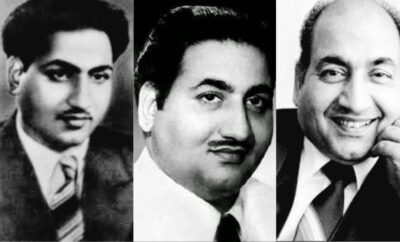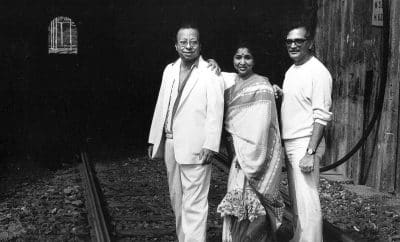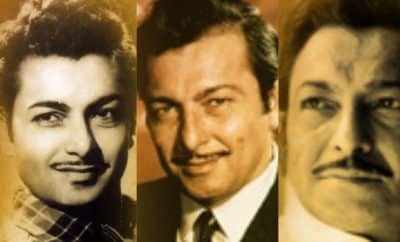Song Sketch
Ye Neer Kahan Se Barse – Rambling Reflections – Prem Parbat
The best thing one can do when it is raining is to let it rain – H. W. Longfellow.
But then what do we do with the emotions which swell up with the rain. Over the years I have realised that the monsoon amplifies the tiniest of emotions in your heart irrespective of its nature – happiness, sorrow, anger, sadness, longing, joy, loneliness. The wind, the clouds, the raindrops, all add up a few layers on those emotions. Our rich literature too, with time, has propped up and fortified these feelings. For example – Kavi Kalidas’ epic poem, Meghdootam. A massive poem with 120 stanzas, this poem is all about a yaksha pining for his wife during the onset of monsoon. It narrates the feelings of this yaksha, who is exiled for a year from King Kubera’s court and has to stay away from his wife. To add more the longing, the yaksha is newly married. The poem brilliantly describes Yaksha’s imagery about his lonely, sorrowful wife and asks the cloud to be a messenger of his love for her.
Since it is the onset of monsoon, the poem describes the situation with –
Ashadhasya prathamdivasay meghmalishtsanu….
It is the sight of that cloud which makes the Yaksha feel more lonely. Whatever follows is his imagery about how lonely his wife must also be. Meghdootam is a beautiful account of his feelings for her. But what about his wife’s feelings? I talked about Ashadh earlier and with Ashadh, also begins the Dakshinayan. It is the feminine half of the year. For me, Padma Sachdev’s Ye Neer Kahan Se Barse Hai is a brilliant poem expressing the feelings and emotions of Yaksha’s wife. When I first heard the song, I thought this is how Yaksha’s wife, who resides at Alaka on Mount Kailasa in the Himalayas, must be feeling about him. And of course we have this creation as a song from Prem Parbat (1973) composed by Jaidev and rendered by the queen – Lata Mangeshkar. The song is an ultra-fine peek into a female psyche. Her feelings of longing, loneliness and craving. Padma Sachdev coherently describes the year full of loneliness without really mentioning it. And since the feelings are subtle, Jaidev has kept the instrumentation subtle too. The song is based on Raag Tilak Kamod. A melodious raag sung mostly at late night making it tranquil in nature. Tilak Kamod enhances the shringar ras, karun ras and bhakti ras hence it is widely played during monsoon season. The song begins with a prelude which has 2 swarmandals (African harps) followed by a distinctive jal tarang with acoustic guitar, blended with soft bamboo flute and madal tarang in the background. Lata Mangeshkar breezes in with soft humming.
Hmmm hmmm hmmm hmm
Ye neer kahan se barse hai
Ye badri kahan se aayi hai….
Padma Sachdev hinting towards the onset of monsoon. The first cloud, the first spell of rain. That again can be the month of Ashadh. The season invites her to ponder on the depths of her emotions.
Gehre gehre naale
Gehra gehra paani re
Gehre mann ki chaah anjaani re
Jag ki bhool bhulaiya mein
Koonj koi baurai hai…
Ye badri kahan se aayi hai
Deep rivers, streams, all the water bodies are full with water. The depth of her heart is also full of love which she was unaware of. Living on this side of the world, without him, the world seems like a labyrinth, confusing her just like the graceful but baffled Demoiselle crane foraging through the water bodies in search of her mate – Koonj koi baurai hai!
Cheedon ke sang aahein bhar lee
Aag chinar ke maang mein bhar lee
Bujh na paaye re, bujh na paaye re
Raakh mein bhi jo,
Aisi agan lagayi hai….
Ye badri kahan se aayi hai
She whimpered and lamented his absence. The tall trees of pine and chinar give her company throughout. The leaves of trees have changed colours hinting the change of season. Aag chinar ke maang mein bhar lee – colour changes from green to red/orange. But still her craving and desire for him remains the same.
Panchhi pagle kahan ghar tera re
Bhool na jaiyo apna basera re
Koyal bhool gayi jo ghar
Wo laut ke phir kab aayi hai…
Ye neer kahan se barse hai
Ye badri kahan se aayi hai..
She’s afraid he’ll forget her. His absence is now plaguing her. She wants to remind him of his home. With the mention of Koyal, Padma Sachdev hints about the arrival of summers. A year long absence from his own house and she is afraid he might never return to her.
From moody blues to deep greys, it shows us all the colours. Mirroring the hues of the Earth, the skies, the trees and reflecting the hues of her thoughts.
Though Padma Sachdev worked with All India Radio, Mumbai, she is mostly known for her work in Dogri language. She has rarely written for Hindi films but her friendship with Lata Mangeshkar was quite known. At one such instance, Lata Mangeshkar visited the AIR, Mumbai for some work. All the officers, workers and members were present to welcome. Padma Sachdev was also there. Lata Mangeshkar was carrying a small but beautiful purse. Padma ji jokingly said – Ye purse main rakh leti hoon, bahot maal hoga isme. But Lata Mangeshkar pointed towards her throat and said – Padma ji, sab maal yahan hai!
When you have a camaraderie like that, songs like this one are bound to happen.
Throughout the song, Jaidev has used the instruments such as vibraphone, acoustic guitar, jal tarang, santoor, madal tarang, elusively. They’re in parallel with her rambling thoughts, her rambling reflections. All those reflections have been captured beautifully with Padma Sachdev’s words. Lata Mangeshkar gave the song its soul. The result is pure alchemy.




Monica Kar
July 29, 2023 at 2:34 am
Deepa, it is always a pleasure to read you but I have to say with this essay you’ve surpassed yourself! What an essay this is! Take a bow, ma’am! I believe that your strength has always been to connect our traditions, mythology and beliefs with the music you hear. You have the sensitivity, the knowledge to look for various symbols and meanings that escape the rest of us in the words. Could you please explain a few things to me that have confused me forever in this absolute stunner of a song? _()_ 1. You say this is written by Padma Sachdev who worked in Dogri language? yet, the word is that the lyrics of this song are written by JNA! 2. What does ‘Koonj’ mean? I believe I understand the meaning of ‘bauraai’ even though I can’t explain it. 3.The word ‘Cheedon’ – are they a type of tree? I would love to know these answers. _()_ I love this “bujh na paaye jo raakh mein bhi aisi agan lagaayi hai…” Deepa, you’ve also added your knowledge of instruments, rasas to this feast where I sit with the Yaksha one minute, and his wife the next, while rubbing shoulders with the demoiselle cranes…not to forget our Hindu calendar. And all this being brought in by Longfellow! Wishing your pen a very long life, Deepa! Blessings!
Deepa
August 7, 2023 at 9:42 pm
Thank you so much, Monica. You are in a way correct about the connect with tradition, beliefs and mythology in my writings. Traditions have always intrigued me. About your questions, I’ll try to answer them. 1. There are total 5 songs in Prem Parbat, 2 have been written by JNA while 3 are by Padma Sachdev. Infact, it is her debut. This song is written by Padma Sachdev, 100%. 2. Koonj is a water bird, has a long neck, often compared to a beautiful maiden. To be specific, koonj is Demoiselle crane, baurana is going crazy over something. 3. Cheed ke ped = pine trees 🙂 Hope I have answered all your questions (though a bit late and I’m sorry for that), once again, thank you so much.
Pratik Mjumdar
May 13, 2024 at 10:29 am
What a beautiful write up this is. This is going in my Saved Folder of Great write ups on music cinema and poetry in general. So little is known about Prem Parbat, the movie. But a listening of the fabulous soundtrack by Jaidev whets the appetite to see the film. I fortunately that can never happen as the prints were burnt in fire, lost forever. But what can happen is a beautiful visual imagery of the moments in the film thanks to wonderful writeups such as this. The sensitivity of the writing transports to that heady feeling of the approaching of monsoons and a thousand emotions that get stirred upon its arrival. Thank you so much for this gorgeous write up Deepa. Makes me want to revisit this marvellous soundtrack all over again.